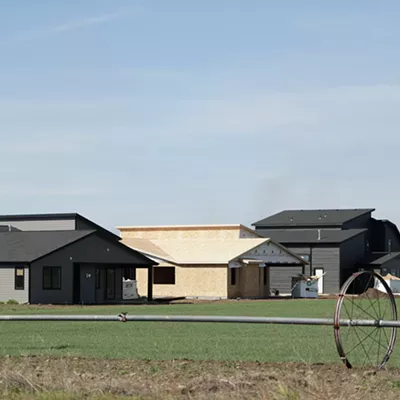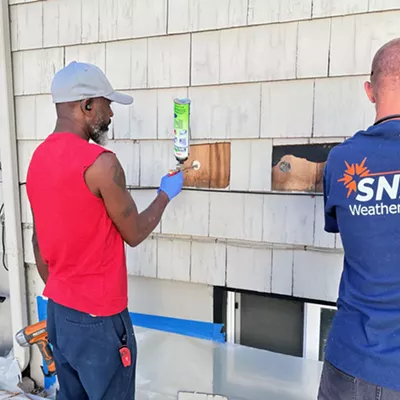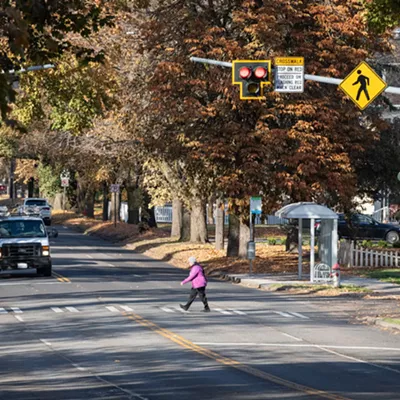"I've spent the last two weeks just thinking about seats," says David Blaine, head chef at Latah Bistro. It's an odd fixation but forgivable for a guy who's going to spend the next three weeks on his ass.
This Friday, after a year and a half of studying and training, Blaine is set to light out from Roosville, Montana, on a 2,500-mile mountain bike ride to the Mexican border as a competitor in the fourth annual Great Divide Race. An informal but organized race that follows the winding Great Divide Mountain Bike Route along the continental ridge to New Mexico, it's a brutal test of both physical and mental endurance. Along the way, Blaine, 38, will traverse snowy mountain passes, cross desolate prairies and possibly brave wildfires in the south. Because he must arrive at his destination within 24 days to be recognized as an official finisher, he'll need to ride more than 100 miles each day, clocking some 16 hours in the saddle before bedding down in a tent beside the dirt trail each night. And with only 16 other riders, he'll likely spend most of that time alone. He'll carry everything he needs in a backpack and in bags lashed to his single-speed mountain bike. (You heard that last part right.)
If all goes according to plan, Blaine will be in southern Colorado by the beginning of this year's Tour de France, where pro riders on ultra-light, geared road bikes will spend only two fewer days riding more than 300 miles less than Blaine. And they'll do it with fans cheering them on and masseurs rubbing them down at the hotel each night.
Sissies.
Blaine is nothing if not prepared, though. Chatting over coffee last week, he spoke like a grizzled veteran of the Divide race. "Getting behind in your mileage is a really bad idea," he says, drawing on the table an invisible map of the 165-mile stretch between Pinedale and Rawlins, Wyoming, "without services, without a tree, without ground water. It's a good idea to get as many miles as you can there." Over the last 18 months, he's read up on the details and lore of the race, spoken with people who have done it, studied maps, tested gear, made lists, gone on training rides, visited an acupuncturist and written about it all on his Great Divide Project blog. (Blaine also blogs about food at From the Back Kitchen.)
He knows that three days into the race, he's going to stop craving salt and start craving fat (and that downing half-and-half is a successful, though hardly appetizing, solution). And he knows that if he doesn't get enough electrolytes, he could fall prey to hyponatremia (rapidly falling blood sodium levels, potentially leading to coma). He knows you have to "clean your butt" when you're not on the bike and that staying in hotels along the way can offer much-needed rest but sap your will to continue.
For as much as Blaine knows, though, he knows, to paraphrase a former defense secretary, that there are known unknowns and unknown unknowns. In other words, you just never know. "There are an amazing number of factors that affect the end result. You're really not in control of what time you get in the end. It's how well did you deal with obstacles," he says, citing the case of a champion rider who broke a pedal halfway through the race, or the story about the guy who broke his entire frame in two and had a new one (and the necessary tools) Fed-Exed to him the next day. All you can do, Blaine says, is expect the unexpected and, when it comes, greet it with, "OK, so here's that thing I didn't expect."
Noah Dimmit never expected a bad case of bursitis to start plaguing him four days into his race last year. The 23-year-old Spokane native, who now works as a bike messenger in San Diego, is returning to the race this year, after inflammation in one knee caused him to drop out on Day Seven last year, in the town of Flag Ranch, Wyoming. "I thought, 'It's just a little bit of swelling. It'll go down. It'll be fine," he says. "But it just got worse and worse."
Even getting out of the Great Divide was a challenge. From Flag Ranch, Dimmit called his mother, who started searching for flights. Meanwhile, he hitchhiked out of town with a couple of passing motorists, stayed with them in Jackson, Wyoming, for a couple of days, then took a shuttle to Salt Lake City, from where he flew home to San Diego. "Just dropping out of the race is an adventure in itself," he says.
Dimmit not only plans to finish this year, but to give the favorites a run for their money. Blaine says he just wants to finish. He's done the math. Only 35 percent of single-speed riders make it to the end in time. The success rate for everybody else is closer to 50 percent. Also (did we forget to mention this?), Blaine is riding to the start line in Roosville in what amounts to a three-day, 240-mile prologue.
But he feels like he has a debt to pay to Latah Bistro, whose crew has given him the time to chase down this Quixotic dream and whose owners, Dave and Heather DuPree, bought him a GPS tracking device with a satellite transceiver that allows them (and anybody else) to track his progress along the way. (He left for Roosville on Monday, June 16, and as of press time Tuesday had made it to Libby, Mont.)
"They're the ones making it possible for me. I have to repay them with my efforts," Blaine says of his Latah colleagues. He promises them -- and himself -- that he's only going to do the race this once. "Hopefully this'll be the last of my crazy ideas."
Five minutes later, he turns and says, "So, I have this idea for a race through the Coeur d'Alene National Forest. Three or four hundred miles. No pre-determined route...."
















